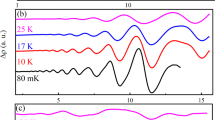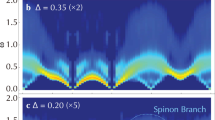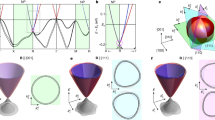Abstract
Quantum states of matter—such as solids, magnets and topological phases—typically exhibit collective excitations (for example, phonons, magnons and anyons)1. These involve the motion of many particles in the system, yet, remarkably, act like a single emergent entity—a quasiparticle. Known to be long lived at the lowest energies, quasiparticles are expected to become unstable when encountering the inevitable continuum of many-particle excited states at high energies, where decay is kinematically allowed. Although this is correct for weak interactions, we show that strong interactions generically stabilize quasiparticles by pushing them out of the continuum. This general mechanism is straightforwardly illustrated in an exactly solvable model. Using state-of-the-art numerics, we find it at work in the spin-\(1/2\) triangular-lattice Heisenberg antiferromagnet (TLHAF). This is surprising given the expectation of magnon decay in this paradigmatic frustrated magnet. Turning to existing experimental data, we identify the detailed phenomenology of avoided decay in the TLHAF material2 Ba3CoSb2O9, and even in liquid helium3,4,5,6,7,8, one of the earliest instances of quasiparticle decay9. Our work unifies various phenomena above the universal low-energy regime in a comprehensive description. This broadens our window of understanding of many-body excitations, and provides a new perspective for controlling and stabilizing quantum matter in the strongly interacting regime.
This is a preview of subscription content, access via your institution
Access options
Access Nature and 54 other Nature Portfolio journals
Get Nature+, our best-value online-access subscription
$29.99 / 30 days
cancel any time
Subscribe to this journal
Receive 12 print issues and online access
$209.00 per year
only $17.42 per issue
Buy this article
- Purchase on Springer Link
- Instant access to full article PDF
Prices may be subject to local taxes which are calculated during checkout




Similar content being viewed by others
Data availability
The data that support the findings of this study are available from the corresponding author upon request.
Code availability
Details about the DMRG code are provided in the Methods and in the Supplementary Information.
References
Liesbeth, V. et al. The quasiparticle zoo. Nat. Phys. 12, 1085–1089 (2016).
Ito, S. et al. Structure of the magnetic excitations in the spin-1/2 triangular-lattice Heisenberg antiferromagnet Ba3CoSb2O9. Nat. Commun. 8, 235 (2017).
Woods, A. D. B. & Cowley, R. A. Structure and excitations of liquid helium. Rep. Prog. Phys. 36, 235 (1973).
Donnelly, J. A. & Hills, R. N. Specific heat and dispersion curve for helium II. J. Low Temp. Phys. 44, 471–489 (1981).
Glyde, H. R., Gibbs, M. R., Stirling, W. G. & Adams, M. A. Excitations in superfluid 4He beyond the roton. Europhys. Lett. 43, 422–426 (1998).
Gibbs, M. R., Andersen, K. H., Stirling, W. G. & Schober, H. The collective excitations of normal and superfluid 4He: the dependence on pressure and temperature. J. Phys. Condens. Matter. 11, 603–628 (1999).
Azuah, R. T., Diallo, S. O., Adams, M. A., Kirichek, O. & Glyde, H. R. Phonon–roton modes of liquid 4He beyond the roton in the porous medium MCM-41. Phys. Rev. B 88, 024510 (2013).
Glyde, H. R. Excitations in the quantum liquid 4He: a review. Rep. Prog. Phys. 81, 014501 (2018).
Pitaevskii, L. P. Properties of the spectrum of elementary excitations near the disintegration threshold of the excitations. J. Exp. Theor. Phys. 9, 830 (1959).
Zhitomirsky, M. E. & Chernyshev, A. L. Colloquium: spontaneous magnon decays. Rev. Mod. Phys. 85, 219–242 (2013).
Stone, M. B., Zaliznyak, I. A., Hong, T., Broholm, C. L. & Reich, D. H. Quasiparticle breakdown in a quantum spin liquid. Nature 440, 187–190 (2006).
Masuda, T. et al. Dynamics of composite haldane spin chains in IPA–CuCl3. Phys. Rev. Lett. 96, 047210 (2006).
Oh, J. et al. Magnon breakdown in a two-dimensional triangular lattice Heisenberg antiferromagnet of multiferroic LuMnO3. Phys. Rev. Lett. 111, 257202 (2013).
Robinson, N. J., Essler, F. H. L., Cabrera, I. & Coldea, R. Quasiparticle breakdown in the quasi-one-dimensional Ising ferromagnet CoNb2O6. Phys. Rev. B 90, 174406 (2014).
Hong, T. et al. Field induced spontaneous quasiparticle decay and renormalization of quasiparticle dispersion in a quantum antiferromagnet. Nat. Commun. 8, 15148 (2017).
Gaveau, B. & Schulman, L. S. Limited quantum decay. J. Phys. A. 28, 7359–7374 (1995).
Zhitomirsky, M. E. Decay of quasiparticles in quantum spin liquids. Phys. Rev. B 73, 100404 (2006).
White, S. R. Density matrix formulation for quantum renormalization groups. Phys. Rev. Lett. 69, 2863–2866 (1992).
Schollwöck, U. The density-matrix renormalization group in the age of matrix product states. Ann. Phys. 326, 96–192 (2011).
Zaletel, M. P., Mong, R. S. K., Karrasch, C., Moore, J. E. & Pollmann, F. Time-evolving a matrix product state with long-ranged interactions. Phys. Rev. B 91, 165112 (2015).
Kojima, Y. et al. Quantum magnetic properties of the spin-\({\textstyle{1 \over 2}}\) triangular-lattice antiferromagnet Ba2La2CoTe2O12. Phys. Rev. B 98, 174406 (2018).
Huse, D. A. & Elser, V. Simple variational wave functions for two-dimensional Heisenberg spin-\({\textstyle{1 \over 2}}\) antiferromagnets. Phys. Rev. Lett. 60, 2531–2534 (1988).
Bernu, B., Lhuillier, C. & Pierre, L. Signature of Néel order in exact spectra of quantum antiferromagnets on finite lattices. Phys. Rev. Lett. 69, 2590–2593 (1992).
Chernyshev, A. L. & Zhitomirsky, M. E. Spin waves in a triangular lattice antiferromagnet: decays, spectrum renormalization and singularities. Phys. Rev. B 79, 144416 (2009).
Zheng, W., Fjærestad, J. O., Singh, R. R. P., McKenzie, R. H. & Coldea, R. Excitation spectra of the spin- \({\textstyle{1 \over 2}}\) triangular-lattice Heisenberg antiferromagnet. Phys. Rev. B 74, 224420 (2006).
Mourigal, M., Fuhrman, W. T., Chernyshev, A. L. & Zhitomirsky, M. E. Dynamical structure factor of the triangular-lattice antiferromagnet. Phys. Rev. B 88, 094407 (2013).
Gohlke, M., Verresen, R., Moessner, R. & Pollmann, F. Dynamics of the Kitaev–Heisenberg model. Phys. Rev. Lett. 119, 157203 (2017).
Verresen, R., Pollmann, F. & Moessner, R. Quantum dynamics of the square-lattice Heisenberg model. Phys. Rev. B 98, 155102 (2018).
Plumb, K. W. et al. Quasiparticle-continuum level repulsion in a quantum magnet. Nat. Phys. 12, 224–229 (2016).
Bhatt, R. N. & McMillan, W. L. Theory of anomalous dispersion in liquid He4. Phys. Rev. A 10, 1591–1597 (1974).
Demkov, Y. N. & Osherov, V. I. Stationary and nonstationary problems in quantum mechanics that can be solved by means of contour integration. Sov. J. Exp. Theor. Phys. 26, 916 (1968).
Basko, D. M. Landau–Zener–Stueckelberg physics with a singular continuum of states. Phys. Rev. Lett. 118, 016805 (2017).
Zimering, S. Some asymptotic behavior of Stieltjes transforms. J. Math. Phys. 10, 181–183 (1969).
White, S. R. & Affleck, I. Spectral function for the S = 1 Heisenberg antiferromagetic chain. Phys. Rev. B 77, 134437 (2008).
Acknowledgements
The authors thank R. Coldea, S. Parameswaran and S. Chernyshev for discussions, and the latter for detailed comments on the manuscript. The authors also thank I. Khaymovich for pointing out the inspiring refs. 31,32. R.V. was supported by the German Research Foundation (DFG) through the Collaborative Research Center SFB 1143. F.P. acknowledges support from DFG Research Unit FOR 1807 through grant no. PO 1370/2-1, TRR80, Nanosystems Initiative Munich (NIM) by the German Excellence Initiative, the DFG under Germany’s Excellence Strategy EXC-2111-390814868, and the European Research Council (ERC) under the European Union’s Horizon 2020 research and innovation programme (grant agreement no. 771537). This research was supported in part by the National Science Foundation under grant no. NSF PHY-1748958 and by the Heising–Simons Foundation.
Author information
Authors and Affiliations
Contributions
All authors contributed equally to this work.
Corresponding author
Ethics declarations
Competing interests
The authors declare no competing interests.
Additional information
Publisher’s note: Springer Nature remains neutral with regard to jurisdictional claims in published maps and institutional affiliations.
Supplementary information
Supplementary Information
Supplementary Text and Supplementary Figs. 1–7.
Rights and permissions
About this article
Cite this article
Verresen, R., Moessner, R. & Pollmann, F. Avoided quasiparticle decay from strong quantum interactions. Nat. Phys. 15, 750–753 (2019). https://doi.org/10.1038/s41567-019-0535-3
Received:
Accepted:
Published:
Issue Date:
DOI: https://doi.org/10.1038/s41567-019-0535-3
This article is cited by
-
Field control of quasiparticle decay in a quantum antiferromagnet
Nature Communications (2024)
-
Instabilities of heavy magnons in an anisotropic magnet
Nature Communications (2023)
-
Bond-dependent anisotropy and magnon decay in cobalt-based Kitaev triangular antiferromagnet
Nature Physics (2023)
-
Kosterlitz-Thouless melting of magnetic order in the triangular quantum Ising material TmMgGaO4
Nature Communications (2020)



